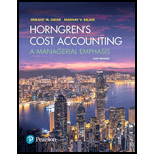
Transfer-pricing problem (continuation of 22-24). Refer to Exercise 22-24. Assume that division A can sell the 1,900 units to other customers at $137 per unit, with variable marketing cost of $2 per unit.
Required
Determine whether Kelly-Elias will benefit if division C purchases the 1,900 units from external suppliers at $115 per unit. Show your computations.
22-24 Transfer-pricing dispute. The Kelly-Elias Corporation, manufacturer of tractors and other heavy farm equipment, is organized along decentralized product lines, with each manufacturing division operating as a separate profit center. Each division manager has been delegated full authority on all decisions involving the sale of that division’s output both to outsiders and to other divisions of Kelly-Elias. Division C has in the past always purchased its requirement of a particular tractor-engine component from division A. However, when informed that division A is increasing its selling price to $135, division C’s manager decides to purchase the engine component from external suppliers.
Division C can purchase the component for $115 per unit in the open market. Division A insists that, because of the recent installation of some highly specialized equipment and the resulting high depreciation charges, it will not be able to earn an adequate
| C’s annual purchases of the tractor-engine component | 1,900 units |
| A’s variable cost per unit of the tractor-engine component | $ 105 |
| A’s fixed cost per unit of the tractor-engine component | $ 25 |
- A. Assume that there are no alternative uses for internal facilities of division A. Determine whether the company as a whole will benefit if division C purchases the component from external suppliers for $115 per unit. What should the transfer price for the component be set at so that division managers acting in their own divisions’ best interests take actions that are also in the best interest of the company as a whole?
Required
- B. Assume that internal facilities of division A would not otherwise be idle. By not producing the 1,900 units for division C, division A’s equipment and other facilities would be used for other production operations that would result in annual cash-operating savings of $22,800. Should division C purchase from external suppliers? Show your computations.
- C. Assume that there are no alternative uses for division A’s internal facilities and that the price from outsiders drops $15. Should division C purchase from external suppliers? What should the transfer price for the component be set at so that division managers acting in their own divisions’ best interests take actions that are also in the best interest of the company as a whole?
Want to see the full answer?
Check out a sample textbook solution
Chapter 22 Solutions
REVEL for Horngren's Cost Accounting: A Managerial Emphasis -- Access Card (16th Edition) (What's New in Accounting)
- What is the company's cost of goods manufactured for the year of this general accounting question?arrow_forwardExercise 2 Make an Excel spreadsheet to compute gross wages due each employee under federal wage-hour law. See notes below. Ryan is normally paid $1,000 for a 40-hour workweek. One week, he works 46 hours. 2.Latisha is normally paid $1,200 for a 40-hour workweek. One Monday she is out sick but receives 8 hours sick pay. She then works 40 hours Tuesday–Friday. 3. Al is normally paid $500 for a 40-hour workweek. One week, he works 45 hours. 4. Lee is normally paid $1,500 for a 40-hour workweek. To make up for leaving early one Friday, he works 44 hours this week.arrow_forwardHello tutor please provide this question solution general accountingarrow_forward
- Get accurate answer of this financial accounting questionarrow_forwardThe cost of goods sold isarrow_forwardRequired information [The following information applies to the questions displayed below.] Kitimat Company manufactures winter hats that sell for $42 per unit. The following information pertains to the company's first year of operations in which it produced 40,100 units and sold 37,600 units. Variable costs per unit: Manufacturing: Direct materials Direct labour Variable manufacturing overhead Variable selling and administrative Fixed costs per year: Fixed manufacturing overhead Fixed selling and administrative expenses 16 $ 16 $ $ 1 $ 2 $401,000 $247,000 9. What would have been the company's variable costing operating income if it had produced and sold 37,600 units?arrow_forward
- Required information [The following information applies to the questions displayed below.] Kitimat Company manufactures winter hats that sell for $42 per unit. The following information pertains to the company's first year of operations in which it produced 40,100 units and sold 37,600 units. Variable costs per unit: Manufacturing: Direct materials Direct labour Variable manufacturing overhead Variable selling and administrative Fixed costs per year: Fixed manufacturing overhead Fixed selling and administrative expenses $ 16 LA LA LA LA $ $ 6612 $401,000 $247,000 4. What is the company's operating income under variable costing?arrow_forwardDo fast answer of this general accounting questionarrow_forwardUsing the high-low method, estimate a cost formula for power cost. ??arrow_forward
 Survey of Accounting (Accounting I)AccountingISBN:9781305961883Author:Carl WarrenPublisher:Cengage Learning
Survey of Accounting (Accounting I)AccountingISBN:9781305961883Author:Carl WarrenPublisher:Cengage Learning Managerial AccountingAccountingISBN:9781337912020Author:Carl Warren, Ph.d. Cma William B. TaylerPublisher:South-Western College Pub
Managerial AccountingAccountingISBN:9781337912020Author:Carl Warren, Ph.d. Cma William B. TaylerPublisher:South-Western College Pub

